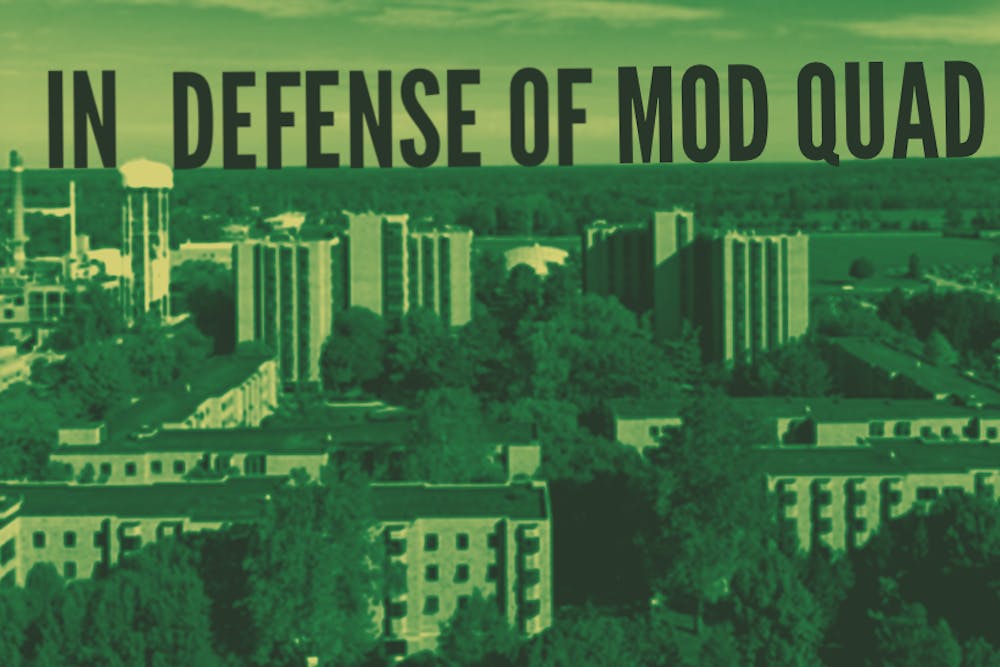Every man, even if he hasn’t touched a bat since elementary school tee ball, thinks he could coach an MLB team. Men feel entitled to kvetch about sports — it’s our birthright. And that’s how I feel about architecture. My career never made it past sand castles, pillow forts and Minecraft houses, but I spend 99% of my time in and around buildings — that’s expertise, no?
So, in honor of Mod Quad Appreciation Week, this amateur architect is stepping up to the plate and batting for his home team — Siegfried Hall — to defend the architecture of Notre Dame’s most maligned neighborhood, Mod Quad.
God Quad and South Quad types (the sort of guy who’s a fourteenth generation St. Ed’s resident, the sort of girl whose great-great-grandpapa came here in the nineteenth century and majored in “race science”) are always the first in line to mock Mod Quad. Their dorms are prim, proper and inoffensive. They’re easy to love — like ice cream or pizza.
Everyone likes ice cream and pizza, of course, but it’s a little disconcerting when you see an adult man licking a strawberry ice cream cone, and it’s a little embarrassing when you hear an adult woman say her favorite food is cheese pizza. God Quad and South Quad are child’s play.
Mod Quad, on the other hand, is for adults. It’s like black coffee or cigarettes. At first it’s a little gross, but then it grows on you. You begin to notice subtleties of flavor, and then you start to become addicted. If we make fun of people with infantile taste in music and movies, then why not in architecture too?
Yellow brick and mansard roofs and statues and dormers: that’s kid stuff. Brutalism, functionality, utility, honesty: that’s Mod Quad.
Keough, O’Neill and Welsh Family Halls boast some similar modernist merits, but they’re handicapped by their location. West Quad is stylistically scatterbrained — a mix of newer buildings, older buildings and newer buildings pretending to be older buildings.
Mod Quad, on the other hand, is cohesive. Walking through the spaces the Pasquerillas form with Flanner and Grace on the one side and with Siegfried and Knott on the other, you feel a sense of place — of coherence. Its oldest buildings were built in the 60s and its newest buildings were built in the late 80s, but everything in Mod Quad still speaks the same language: the same forms, the same windows, the same materials, the same colors. The architectural conversation extends past the dorms to the surrounding buildings, so that — even though everyone uses them — Flanner and Grace, the Hesburgh Library and North Dining Hall still feel distinctively “Mod Quad.” It’s a true neighborhood.
East Quad’s dorms have a family resemblance with each other too, of course. But still, they lack an architectural identity because they contradict themselves. Essentially, they’re modern dorms like Knott or O’Neill (indeed, even nicer), but visually, they pretend they’re vintage dorms like the sort on South Quad and God Quad — e.g. Flaherty Hall feels like Welsh Family Hall wearing the skin of Howard Hall, “The Texas Chainsaw Massacre” style.
I’m reminded of the Italian Futurists, artists who aimed to “destroy the cult of the past, the obsession with the ancients, pedantry and academic formalism” and extolled the beauty of “the vibrating nocturnal fervor of factories and shipyards burning under violent electrical moons; bloated railroad stations that devour smoking serpents; factories hanging from the sky by the twisting threads of spiraling smoke; bridges like gigantic gymnasts who span rivers, flashing at the sun with the gleam of a knife.”
I’m proud to live in a place they would have loved, a place which isn’t pretty but is beautiful — I’m proud to live on Mod Quad.










